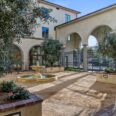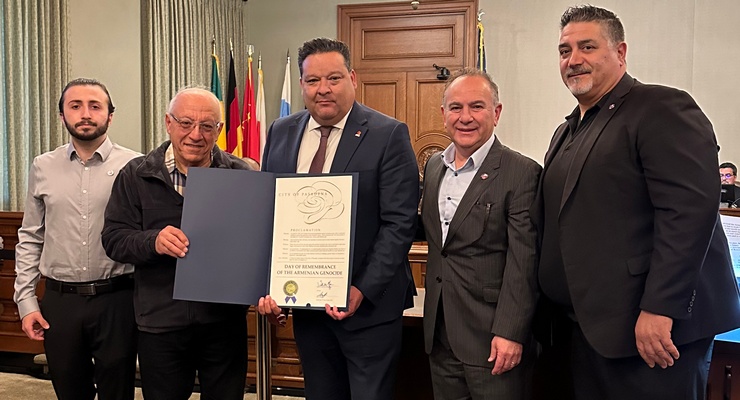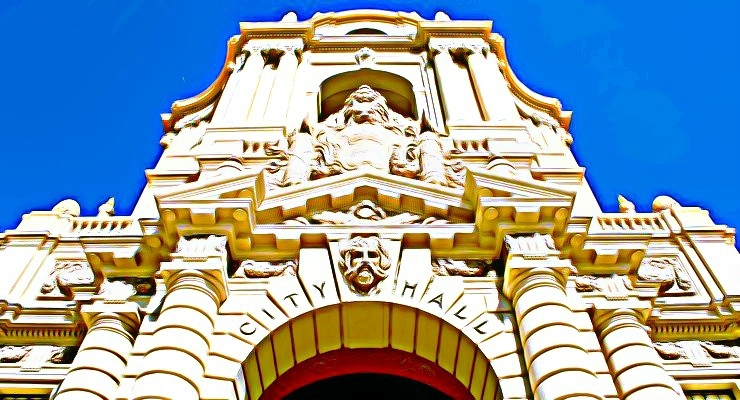
The developers proposing a condominium project on the site of the New Orleans Colonial-style Thatcher Building Medical Center in Green Street’s Village district took their case to the community Thursday evening as they prepared to appeal the rejection of an Affordable Housing Concession Permit and move forward with the planning process.
The town hall meeting at Polytechnic School was arranged by Councilmember Andy Wilson, who called the evening a “workshop” and told the audience that he had no position on the development yet and was there to “listen and learn.”
“No decisions will be made here tonight,” Wilson said.
The two existing office buildings, at 960 East Green Street, and 99-135 South Catalina Avenue — built in 1948 and 1961, respectively — are together known as the Thatcher Building Medical Center.

The owner and developers, American General Design, had requested the housing concessions in order to build 20 residential units on the second and third floors of the three-story Green Street building, and to construct a new four-story 79,365 square-foot multi-family residential building with 117 units at the Catalina Avenue address, currently the site of the Center’s parking lot.
The four-story, multi-family residential building on Catalina would be developed behind the Thatcher building, and 461 parking spaces would be provided within three new subterranean parking levels.
A total of 137 new units are planned, with 12 designated as “very low income.”
Thursday night’s audience, made up of doctors, patients, neighbors and nearby business owners, were decidedly cool to the project, which was presented by American General representative Robert Montano.
Montano told the audience that it was still early in the construction and permit process.
“We are still at least 24 months from shovels in the ground,” he said. “Nothing has been submitted for design consideration.”
Montano, who presented a number of options for the development, also assured the attendees that no apartments or residential units would be built in the medical center building itself.
“We would leave the Thatcher building 100 percent medical,” he said.
He also said that the locations of the affordable housing units are to be determined by the City, not by the developers.
“Those units would be scattered throughout the building,” he said.

Most, but not all, audience members did not seem to support the project.
At one point, the beleaguered Montano asked the crowd directly: “Is there a project here?,” and was greeted by a resounding “No!” from the audience.
Most of the complaints from attendees at the meeting centered around the two-year construction process for the new “by right” development.
Dr. Charles Niesen, a child neurologist, told Councilmember Wilson, “This is one of the most ill-conceived, ridiculous ideas I’ve ever heard of in my life. You’re putting construction 20 feet away from a medical building. There are over 40 physicians and professionals in that building. How the heck are my patients going to get into that building, and find parking over the two years of construction, and even after that construction?”
Niesen continued, “You have construction 20 feet away from a psychiatrist, from people who need privacy… I have handicapped patients and older patients. How the heck are they going to get from the underground parking and come up and see me when the construction is going on?”
“You’re putting a two-year chokehold on my business,” said said Dr. Craig Johnson, a family practice physician and Thatcher tenant, echoing Niesen’s comments. “By the time the construction is done, my business will be alive, but brain dead.”
Added Dr. Cleo Williams, “You’re killing our neighborhood and our community spirit.”
During the meeting, Pasadena Director of Planning and Community Development David Reyes explained the permitting process to the group, as well as the classification of “by right,” a term, he said, which is often “over-used” by developers.
“By-right means that a project follows all the zoning requirements for a particular parcel,” said Reyes, “but it can also mean that a project still needs some variances from the City in order to build the project as it is originally designed.”
Reyes also said that “This project will change the fabric of our community,” and added later, “Growth and development comes with consequences.”
The question then arose as to whether or not the building could be built without the affordable housing concessions, a question Montano appeared reluctant to attempt to answer.
“To be honest, I don’t know. That’s not up to me,” he said.
Wilson said that the City of Pasadena is working to develop a new specific plan and that given the fact that the current local zoning code may allow buildings like the Thatcher development, perhaps a “zoning change was needed.”
Asked later if he would support such a move, Wilson said, “Yes, and in other neighborhoods as well.”
Not every attendee at the meeting was against the development, however.
New resident and homeowner Dr. Alexander Arrow, said, following the meeting, “To me this seems like an architecturally attractive addition to the neighborhood that appears to have just an open parking lot.
“Typically,” Arrow continued, “parking lots that are just parking lots, are not desirable to a community, they’re not attractive, they’re just asphalt, and what has been proposed here has some green space, has multiple layers of what looks like green or LEED components, which to me, would be an enhancement to the community.”
Arrow concluded, “If we never take any action that upsets anyone, we can never make any progress.”
After the meeting, Montano emphasized that he is a Pasadena resident with ties to the community, with a number of responsibilities to be mindful of.
“Even if all the doctors approved, I don’t know if we’re building in this cycle, or in the next cycle, or even not building,” he said.
“We have to be responsible to the tenants of the building, to the patients, and to the local business owners,” Montano said, adding, “I think it’s really important for people to know that we came to this site because we’re local, and we are proposing this project because we are local. We don’t want to push the limits on anything. We are going to work with everyone, all of the stakeholders to try to figure out how to find solutions.”
Montano concluded, “I don’t know what all the solutions are yet, but we need to continue to explore, to understand what they might be.”













 0 comments
0 comments


